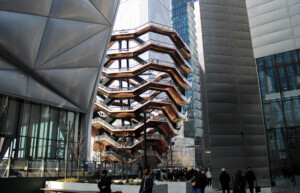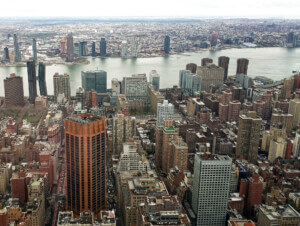Heatherwick Studio’s 150-foot-tall climbable sculpture Vessel has been closed to the public after a third person in less than a year committed suicide by jumping from the artwork earlier this week. The monumental, honeycombed staircase-jumble is a major tourist attraction and serves as the centerpiece of Related Companies’ multiacre Hudson Yards on Manhattan’s West Side. It opened to the public in March 2019.
The first tragedy occurred in early February 2020 when a young man from New Jersey jumped to his death from the $150 million interactive sculpture. In late December 2020, just ahead of Christmas, a woman took her own life in the same fashion. Now, less than a month later, Vessel served as the backdrop—and vehicle—for another tragic event, which occurred on the morning of January 11 and involved a 21-year-old man from Texas, per the New York Post.
Yesterday, January 12, the New York Times reported that Related Companies has decided to close Vessel to the public indefinitely. A spokesperson for Related had told the Times that the sculpture would remain off-limits to the public temporarily while it consulted with suicide-prevention experts and psychiatrists on steps moving forward. Separately, Lowell Kern, chairman of Manhattan Community Board 4, indicated to the Times that he had been told by Related that Vessel would remain “closed until further notice” as Related reviews preventative measures to limit further suicides, which will later be presented to the board before the sculpture reopens. The Vessel ticketing website currently reflects this closure.
AN reached out to Related last evening for comment after learning of the closure and will update this story accordingly.
Concerns over the Vessel’s open-air nature aren’t new; see the grimly prescient 2016 critique of Heatherwick’s sculpture by AN contributor and former associate editor Audrey Wachs, who drew comparisons of the then-uncompleted Vessel to the previously barrier-free design of the central atrium at the Philip Johnson and Richard Foster-designed Bobst Library at New York University, which was the site of two suicides in 2003 and prompted the university to install Plexiglass barriers. Another suicide occurred in 2009 when a student scaled the protective barricades, leading to the installation of floor-to-ceiling metal fencing.
Wrote Wachs:
As one climbs up Vessel, the railings stay just above waist height all the way up to the structure’s top, but when you build high, folks will jump. After a student leapt into the soaring central atrium of NYU’s Bobst Library seven years ago, the school installed metal fencing—on top of the Plexiglas barriers it had put in years earlier in response to other suicides. Philip Johnson and Richard Foster didn’t see the death in the design that the public’s morbid ideation uncovered, but Ross [Related chairman Stephen M. Ross] and Heatherwick seem not to have learned from Bobst, or from the city’s bridges and iconic tall buildings. If barriers are installed, how will they affect the views, Vessel’s main selling point?
As reported by the Post, the man who took his life at Vessel earlier this week was being sought for questioning by authorities in San Antonio following the fatal stabbing of his mother.
The National Suicide Prevention Lifeline can be reached 24/7 at 800-273-8255.











